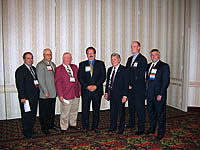
- Kevin Mahan, Vice President, Field Systems, Jamesbury/Metso Automation.
- Steve Letko, Account Manager, Latin/South America/Domestic Projects, Weldbend
- Joseph Avento, Executive Vice President, Outokumpu
- Ron Lafferty, President, Pennsylvania Machine Works
- Gary Moore, Executive Vice President, Victaulic Co. of America
- Mike Stefko, Sales Manager, Industrial Products, IPSCO Tubulars.
What follows are some of the highlights of the provocative Q & A session.
Can your company stay competitive with imports?
Letko: We are betting heavily on it at Weldbend by investing heavily in the latest automated equipment for machining. We are also investing in computerized equipment to facilitate shipping, handling and order processing to eliminate manhours of labor and increase productivity per person.The biggest problem exists when we run into countries that subsidize the products of companies we compete against. This artificially reduces their cost structure, and we cannot be competitive against that.
Lafferty: We also have continued to invest heavily in the latest production equipment, training of our people, and the adoption of lean manufacturing techniques in every part of our process, as well as EDI to drive down transaction costs. It's a chronic investment challenge to stay ahead of the curve, but you have to do it to compensate for the low labor costs in developing countries, and their lack of governmental oversight. Agencies such as OSHA add cost to U.S. manufacturing that other countries are not burdened with.
In spite of the political rhetoric, we believe that much of the job loss in U.S. manufacturing is due as much to productivity enhancements as to offshore purchases. Given fair and equitable trade rules, we can compete with anyone, anywhere.
Do you see pricing or availability changing or remaining stable over the next 12 months?
Lafferty: As of this date, our best information is that pricing and availability will continue to be unstable, and under some scenarios could worsen. The world's political situation, currency exchange rates, a significant uptick in demand and a host of other factors could alter the present equation dramatically.Letko: At Weldbend, we see price and availability volatile as far out as 2008, basically due to emerging countries and their appetite for expanding infrastructure.
Stefko: We are very involved in the world market and think availability will improve. It already has, although volatility will continue. We are now monitoring growth in China and other emerging nations so we can better project and forecast material requirements. Pricing will trend upwards.
Are mechanical contractors moving toward the use of more foreign product?
Moore: Yes, they are, because distributors are sourcing foreign products. Not all foreign products are of low quality. We have a global brand, and we don't care where it was manufactured, as long as the quality is there.Mahan: There's a fine line between foreign product and product that meets specifications. All manufacturers have to work hard to keep products competitive. Once installed it has to work. Most customers want to see a reputable company standing behind it. In most cases, distribution is finding that it becomes difficult for domestic manufacturers to keep up with foreign manufacturers that do not have to abide by the same regulations, and distributors have to have what the customer wants.
Lafferty: Mechanical and commercial contractors are notorious for looking at invoice prices, but rarely consider the additional costs of inventory carrying charges, transaction costs and the invisible risks of inferior components. Witness the Chinese and Indian flange debacles of several years ago. There simply is no substitute for a healthy and robust U.S. manufacturing base.
Are wholesalers and contractors alike destined to really look at the total cost to procure with regard to inventory cost, transportation, return policies, “just in time,” etc., instead of simply invoiced line item cost?
Moore: Installed cost is paramount to the contractor like no other time in construction history. The manufacturer and wholesaler supply chain is only part of that. About 42% of the cost on a construction site is direct or indirect materials handling cost.
Lafferty: Absolutely! If anyone is to stay in business in a competitive environment, it is mandatory to calculate the “total” cost of any product or service. We constantly monitor our vendors for all of those elements. Most often we find that the cheapest invoice is not the lowest cost vendor.
On a scale of 1 to 10, how do you rate the manufacturer-distributor relationship today and where it is headed?
Lafferty: With major distributors, we would rate the relationship factor at an 8 or 9. I think that our distributors have a good understanding of total value and what that means to their company day in and day out.Stefko: I'd give a score of 10. Since 99% of our product is sold through distribution, it's extremely important to our company that we all pull together. We exchange market intelligence with our distributors. We see them as an ally to help take costs out of the supply channel and build a better mousetrap.
Mahan: Pressures in the marketplace have added new complexities to the manufacturer-distributor relationship. In many cases that has led to conflict, but there also has emerged a more open dialog that has resulted in improved understanding.
What can be done about the decline of specification integrity? It seems more and more products are finding their way onto commercial jobsites without the traditional or appropriate approvals.
Moore: Very few consulting engineers will stand behind commercial specifications. The work being done by good quality rep firms and manufacturers to get quality products specified falls by the wayside. I don't know what the industry can do about it.Mahan: Specification issues can and should be enforced through the owner of the mark that is being violated, such as UL, NSF, etc. On the industrial side, the key is understanding what the laws are with regard to product, as well as specific insurance requirements. It helps you make a case if you have understanding.
Lafferty: There is no substitute for education. We have prepared extensive training materials that we love to present to end users in conjunction with our distributors. These cover things such as material mixes, installation issues, etc. These presentations are always eye openers even for seasoned professionals.
When a foreign product fails, who takes financial responsibility?
Lafferty: Usually it's the last guy who bought it. The distributor tends to send it back to the importer, and it becomes a case of finger pointing, but the supply chain is so long and cumbersome that the distributor ultimately takes the hit.Where would you guess the price range to be for steel pipe at the end of 2005?
Stefko: With the current volatility, it's hard to predict anything through 2005. Demand for steel from emerging nations will continue to grow at alarming rates.
This is a whole new world we're still trying to figure out. Prices have gone high before only to fall off, but I see nothing in the variables that will lead to a decline. If any downturn comes it won't happen until the last half of 2005, and any downturn will be due to something unexpected, not to anything we see now.
What is the future with regard to the availability of stainless pipe and fittings?
Avento: Stainless pipe has doubled in price in the last 18 months. The price of nickel is extremely high, and the gurus in Finland expect prices to stay the same for the next four or five months. A small decline is possible in 2005, but it's still a supply and demand issue. There is a shortage of capacity to produce all the steel the world needs, and especially a shortage of bars and pipe. Stainless still will be in moderately short supply going into 2005, although I expect that to be corrected.Lafferty: Chinese demand is a real factor, as is the export of scrap and the constraints at the nickel, chrome and moly producers. We just don't know, although the most prudent expectation is for strength to continue with the possible leveling off at a high level. However, we've been around long enough to know that these conditions can evaporate as quickly as they came. <<
- Jim Olsztynski


